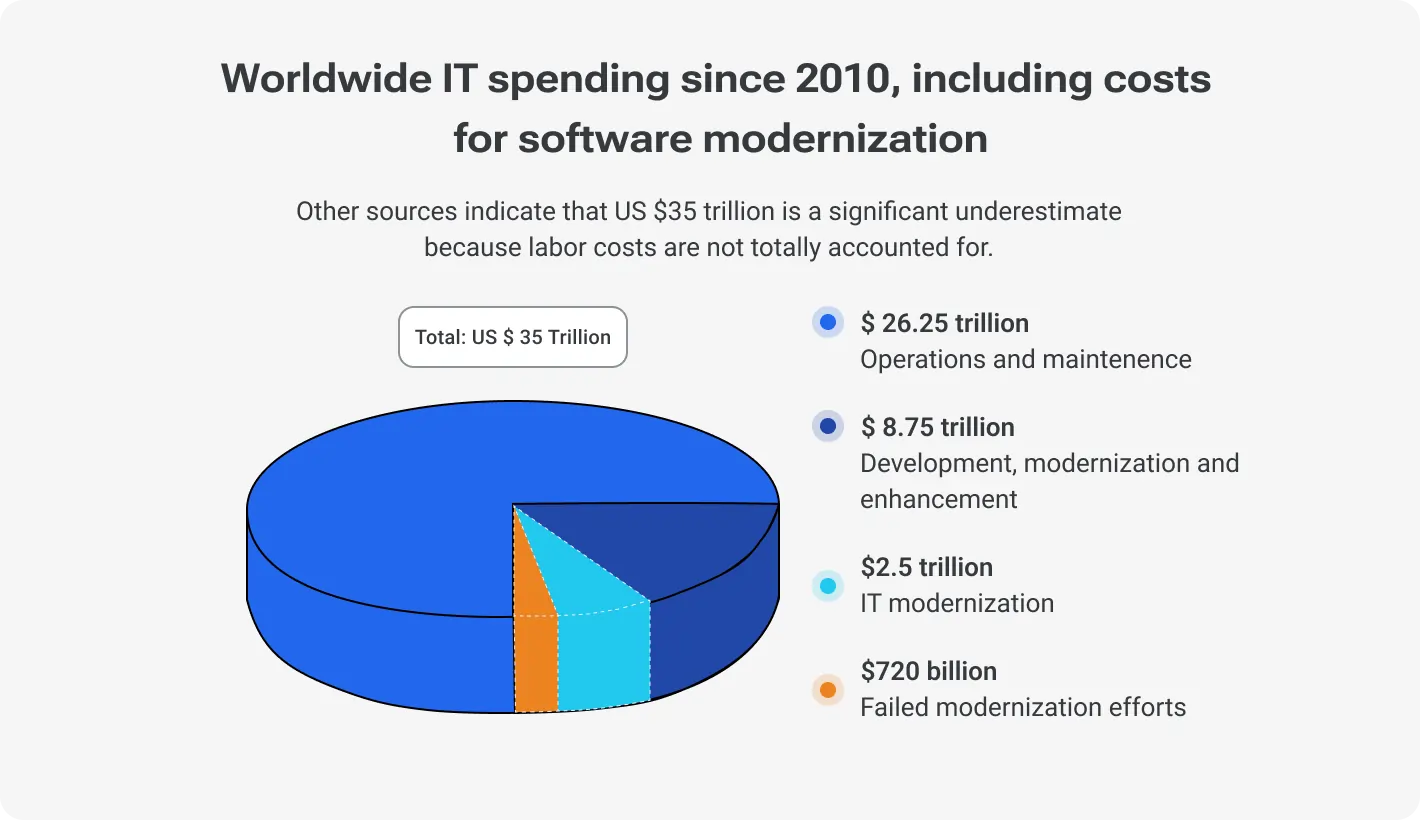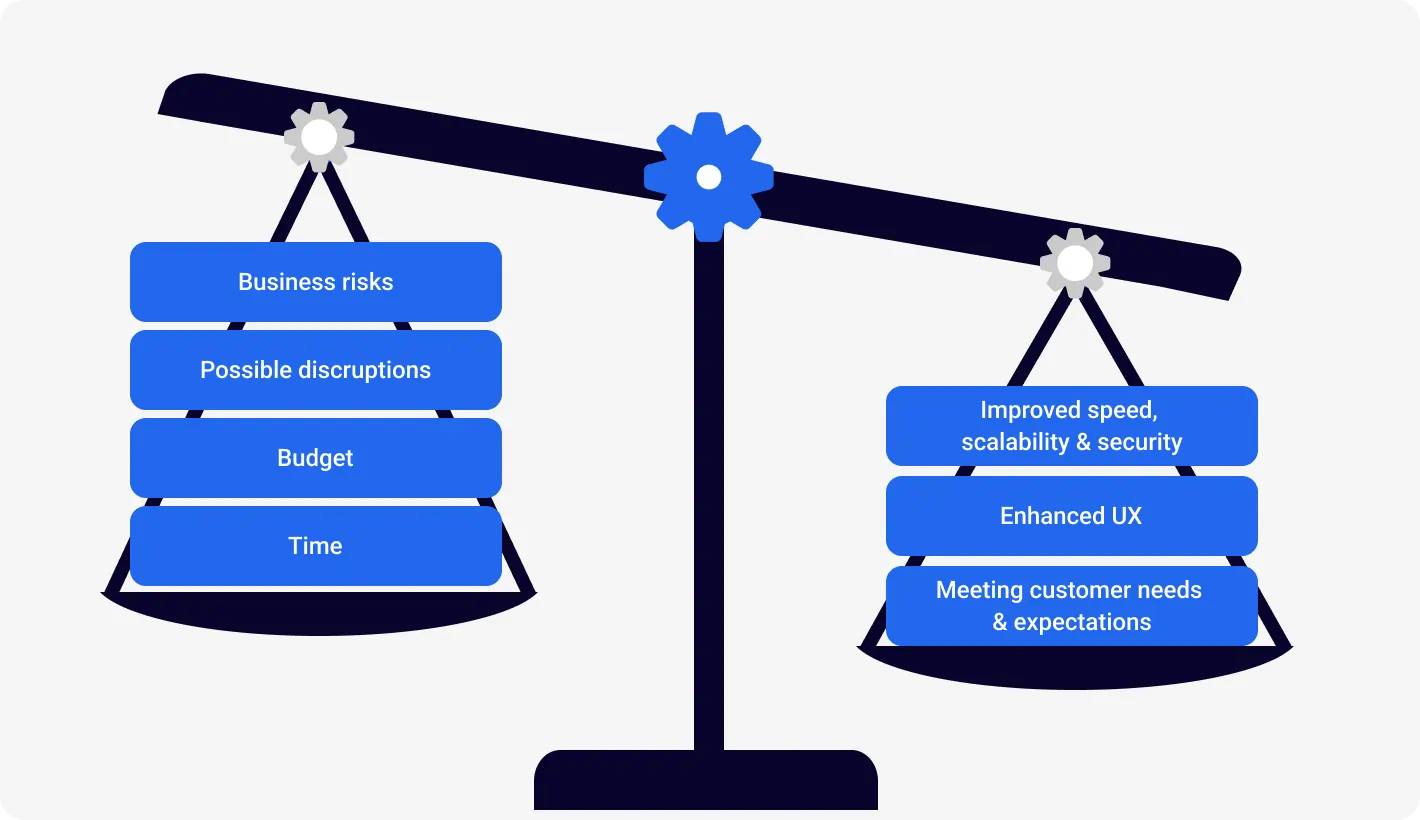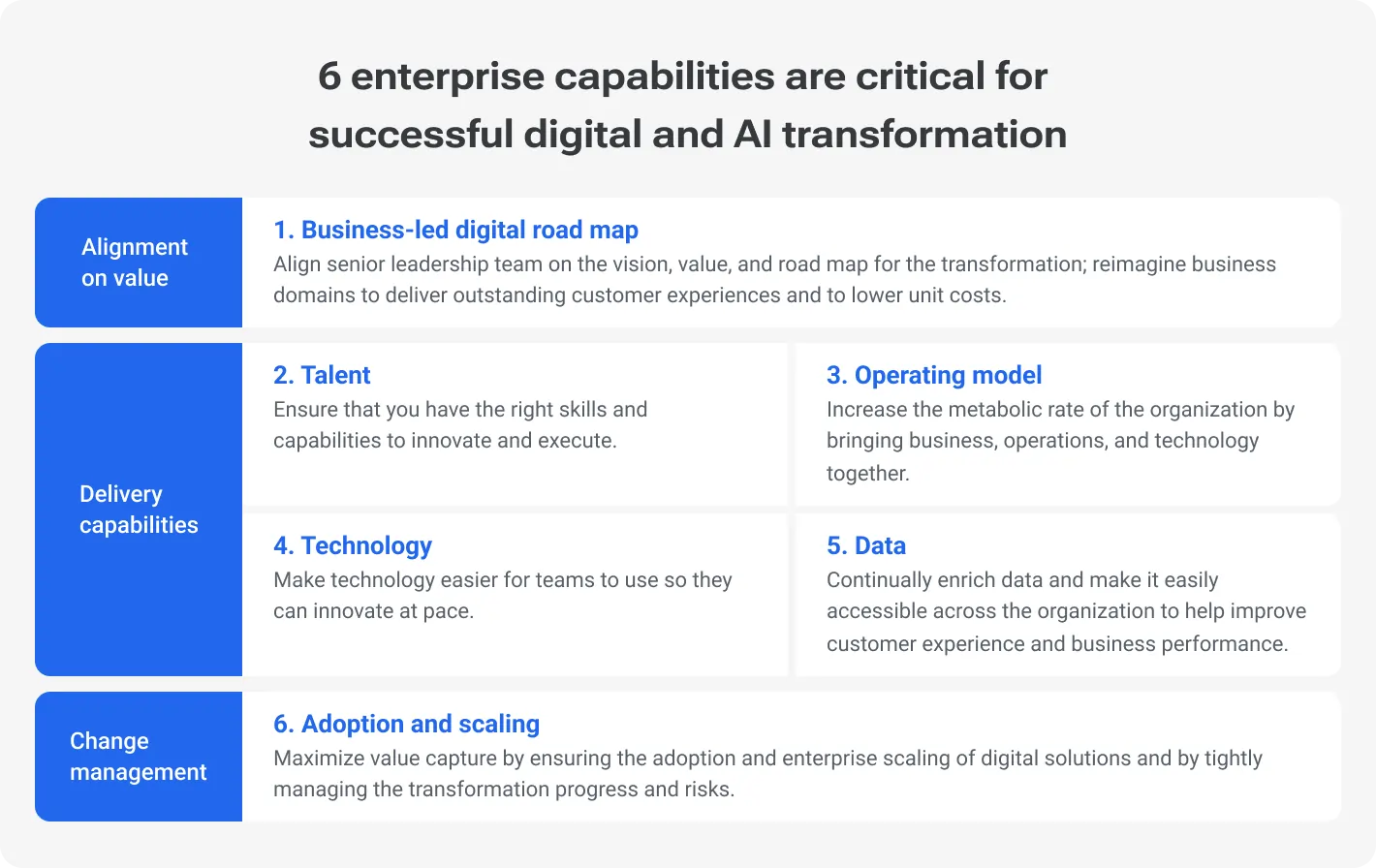Outdated systems often act like clunky, gas-guzzling cars trying to keep pace with sleek, high-performance electric vehicles on the highway. Not that we’re experts on gasoline cars, but we think you get the comparison.
These outdated software applications and infrastructure, once the workhorses of the past, struggle to meet the demands of modern business. Yes, they may have served their function perfectly in the past, but now the customers want more. They want cool results quickly, efficiently, and right now.
Nowadays, technological agility is a fundamental requirement for success. Harvard Business Review summarized different surveys on digital transformation and found that companies embracing legacy modernisation initiatives experience at least 35% higher revenue growth and at least 25% cost savings.
90% of companies have launched at least one direction of digital transformation.
This bears witness to the fact that legacy systems can act as a major barrier to agility. They are often inflexible and difficult to adapt to changing market needs and new technologies. This inflexibility can hinder innovation, making it challenging to develop new products and services or improve existing ones.
Security vulnerabilities are probably the most obvious and the most dangerous risks of outdated systems. MailChimp, MOVEit, and even the UK Electoral Commission — these other-day breaches will keep other companies from spitting on security measures. Recall Blockbuster. Worn-out example, yet still remarkable. Its reliance on legacy systems and inability to adapt to the streaming revolution ultimately led to its bankruptcy in 2010. At the same time, Netflix embraced technological advancements, and continues to thrive as a global leader in the entertainment industry.
Scale your business effortlessly with modernized IT solutions
Further, we'll explore how outdated legacy systems keep you away from rapid growth. Also, we’ll provide comprehensive strategies for overcoming such challenges.
The Impact of Outdated Legacy Systems on Business Growth
We feel you, obsolete systems used to be a safe haven for you. But now we can fully return to the metaphor from the introduction about cars — it's the time of elegant electric cars, not outdated crews that pollute the planet with gasoline fumes. The same story with out-of-date systems — they hold your business back in several critical ways, hindering your ability to compete and grow in the modern market.
Decreased Efficiency and Productivity
What are the main characteristics of the legacy systems? They’re slow. They often require manual data entry and have complex workflows. And the cherry on the top of the cake — they have limited automation capabilities. At the end of the day, you waste time and resources struggling with even basic tasks. The most terrifying is that US businesses still spend up to 75% of their IT budget simply maintaining legacy systems. Just imagine how many innovative solutions they could bring to life if they get rid of legacy systems.
This is not to mention the integration issues, which create additional roadblocks to efficiency. This data siloing hinders collaboration and slows down information flow, making it difficult to gain comprehensive insights and make data-driven decisions.
Nothing Groundbreaking Will Happen: In Any Sense
Today’s customers want more. Lightning-fast page loading. Ordering with a thumb. Easy-to-perceive interface. Robust data security. That kind of thing. And without modernizing legacy applications it’s quite difficult to ensure a smooth user experience and adapting new technologies.
Not to be unsubstantiated, let’s take an example from e-commerce. The conditional conceptual brand for the youth, “Blursday”, relies on a legacy system for managing its online store. If the system cannot be easily updated to integrate with new payment gateways or support mobile commerce functionalities, the business will fall behind competitors who have embraced a more agile technology stack.
New technology integration is much more challenging without a legacy modernization strategy and holistic approach. This lack of adaptability can leave your business at a significant disadvantage in the long run. Furthermore, legacy systems can pose significant challenges connected to security.
Increased Risk of Security Breaches and Compliance Issues
Legacy systems often lack the robust security measures necessary to protect sensitive data in today's ever-evolving threat landscape. Outdated software and hardware are more susceptible to vulnerabilities that cybercriminals can exploit, putting your business at risk of data breaches, malware attacks, and financial losses.
The very beginning of 2024 marked perhaps the biggest failure in cybersecurity history. The Mother of All Breaches bombshelled over 26B records. And even though some of the “holes” that leaked data have already been “patched”, the incident is incredible. This is not to mention the reputational damage due to non-compliance with data privacy regulations.
Legacy systems often make it challenging to maintain proper data governance and ensure compliance with evolving regulations like the General Data Protection Regulation (GDPR) in Europe and the California Consumer Privacy Act (CCPA) in the United States. The regulations are simply taken out of context, but nevertheless, the message is clear.
Customer Experience and Satisfaction Weakening
Legacy systems can also negatively impact the customer experience. Slow and outdated user interfaces, limited online functionalities, and difficulties in integrating with modern customer service tools can lead to frustration and dissatisfaction. By the way, 47% of users are steadfast about the time of loading a web page — 2 seconds or less. 2 seconds.
In addition, seamless and personalized experiences across all touchpoints are non-negotiable in today’s world. If your business is hampered by outdated legacy systems, you may struggle to meet these expectations, potentially driving customers towards competitors who offer a more modern and user-friendly experience.
Reasons Why Legacy Systems Persist
Any application modernization roadmap brings a touch of anxiety to the life of any professional involved. Because it’s a new environment, new challenges, and a new way to solve problems. On the one hand, the drawbacks of outdated systems are evident. On the other — many businesses continue to rely on them due to a combination of internal challenges and a lack of understanding.
Let’s dig into some of the key reasons, pitfalls, and examples.
1. We Simply Don’t Like Changes
The Stanford Marshmallow Experiment proved that if you can delay gratification, you’re more likely to succeed. But there is a thing. Anything new, even when strategically advantageous, can hit you with fear. Especially when it comes to business change. Companies may experience inertia and resistance from various stakeholders:
Employees accustomed to existing workflows: Team members who have been using a specific system for years may be comfortable with its functionalities and apprehensive about learning a new one. Actually, if we believe James Clear (linked his thoughts on the Stanford Experiment above), this is the new normal. In the Stone Age, primitive people had to constantly adjust to their environment. Now the environment is quite predictable (it was until 2022, at least). Anyway, they can hinder adoption and user buy-in.
Managers apprehensive about the challenges: Managers may worry about the potential impact of a modernization project on project timelines, employee productivity, and overall business continuity. This fear of the unknown can lead to decision paralysis and a reluctance to embrace change.
Pay attention to: Businesses that fail to address inertia and resistance effectively can experience implementation delays, reduced user adoption, and decreased return on investment (ROI) from their modernization efforts. Zero in on ROI, almost always it’s the reliable reflector of your effectiveness.
Example: A large retail chain attempted to modernize its Point-of-Sale (POS) system. However, due to inadequate change management and insufficient training, employees resisted using the new system. Then — frustration and inefficiencies. The company ultimately had to invest additional resources in training and user support to overcome these challenges.
Learn more about why businesses should modernize their legacy applications
2. Budgetary Constraints and Perceived Costs of Modernization
Remodeling is often like a reverse mortgage. Usually, you get an apartment (conventionally, the profit from modernization) and gradually pay money for it. But here it's the other way around — you pay first and get the profit only over time. That's how it works, and it's worth it.
Here is how to make such an investment competently.
Software licenses or subscription fees: Replacing legacy systems with modern solutions can involve acquiring new software licenses or subscribing to cloud-based services, which require ongoing financial commitment. Keep calm, it;’s an investment in security. Ask 23andMe representatives, they may agree to pay 2x more than encounter a breach again.
Hardware upgrades: The modernization approach will define if this step is necessary. You may need to invest in new hardware infrastructure to support the updated systems.
Integration costs: The process of migrating data, integrating new systems with existing ones, and customizing functionalities can incur additional costs.
Training: Your employees must be ready to operate the new software. Otherwise, they just will be ineffective in any sense.
You may think something like, “It's killing business! What a load of money!” However, the perceived cost of modernization needs to be sized up in comparison to the hidden costs of maintaining legacy systems.
Decreased productivity: Outdated systems a priori are slow and onerous. And one more time, they simply waste employee time and reduce efficiency.
Security issues: Any out-of-date system is, by default, more susceptible to cyberattacks, which can result in data breaches, and hence, in financial losses, and reputational damage.
Growth? That’ll be the day: Growth is a synonym for innovation, which automatically excludes any outdated software. If you struggle to adapt to changing market demands, you’ll never be on the top of the curve.
Pay attention to: If you solely focus on the initial costs of modernization, you may overlook the long-term cost benefits and miss out on the potential return on investment (ROI) that modernization can offer.
Example: A manufacturing company continued to rely on an old, on-premise ERP system due to budget constraints. Yet, they simply weren’t able to automate operations and scale their business. At the end of the day, the company's competitors, who had invested in modern cloud-based systems, gained a significant competitive advantage. Obviously, this led to lost market share for the company clinging to its legacy system.
3. Disruptions and Downtime: The Main Fears
Legacy modernization strategy should include some time for moving over to a new operational flow and adopting new technology. You may be going through some unpleasant periods, that’s true.
Operational disruptions: Migrating data, implementing new systems, and integrating with existing ones can disrupt day-to-day operations and workflows.
Downtime: During the transition, certain systems may be unavailable or experience performance issues, potentially impacting customer service and productivity.
Data loss or security risks: Concerns about data loss or security breaches during the migration process can create anxiety and reluctance to proceed with modernization.
But again — let’s look through the delaying perspective. Missed opportunities, maintenance costs, and potential breaches… Additionally, the mentioned risks can be mitigated through careful planning and a phased approach to modernization.
Thorough planning: Identify potential disruptions before they occur. Downtime periods are not mandatory but still likely. Considering all these facts, you can develop a detailed plan for transition.
Clear communication and user training: Keeping employees informed about the process is probably the most important part. Openly speak about the timeline and potential disruptions; this can help alleviate anxieties and ensure cooperation.
Gradual rollout and rollback plan: Don’t rush. Find your pace and realize the modernization strategy through all stages. It’s also important to have a well-defined rollback plan. Just on the off chance, as it minimizes the impact of unforeseen issues.
Pay attention to: Turn potential for disruptions and failure to adequate preparation. Otherwise, this can lead to significant operational challenges, financial losses, and damage to customer relationships.
Example: We all are dreaming of a huge success. But the thing is that it often comes across as a "big bang" approach. Imagine a healthcare company wanting to migrate its patient records system to a new platform in the blink of an eye. Yet, such plans are inadequate, and the migration process encountered unforeseen technical difficulties. As a result, it’s more likely to extend downtime and get inaccessible patient records.
4. Lack of Awareness about Inaction Consequences
A clear understanding of the long-term consequences of clinging to legacy systems is key. Carlos Castaneda used a similar practice to fill himself with determination. When you realize that your business (or body, in Castaneda’s case) may cease to exist, it is much easier to decide to change.
Never underestimate the impact of outdated technology on their ability to:
Compete effectively: If you lack agility due to outdated systems, you may struggle to keep pace with competitors who have embraced modern technologies. Then, don’t be surprised by lost market share, decreased profitability, and, ultimately, the inability to sustain growth.
Innovate and adapt: Outdated systems often hinder innovation and make it difficult for businesses to adapt to changing market trends and customer demands. This can limit their ability to develop new products and services, respond to emerging threats, and capitalize on new opportunities.
Attract and retain talent: Skilled professionals are increasingly seeking out employers who offer modern work environments and opportunities to utilize cutting-edge technologies. In this case, clinging to legacy systems will make you struggle to attract and retain top talent.
Pay attention to: Mindfulness reigns supreme. In a business environment, too. Recognize the long-term consequences of inaction, and you’ll never be tricked by a false sense of security.
Example: A financial institution continued to use a legacy core banking system despite its limitations. This made it difficult for them to offer new digital banking services and integrate with modern financial technologies. As a result, the company lost ground to competitors who had modernized their systems and struggled to attract new customers, ultimately impacting their long-term growth prospects.
Strategies to Overcome the Challenges Posed by Legacy Systems
Business growth occupies probably the biggest part of an owner's mind. And rightly so. So, outdated systems stifle your growth by leaps and bounds. Yet, overcoming these challenges doesn't have to be an insurmountable task. Select some key strategies to guide you on your journey.
Complete Assessment of Existing Systems
Very simple, basic, and obvious. Yet, effective and mandatory. While you may be comfortable with your legacy systems, a thorough assessment is crucial to uncover hidden inefficiencies, security vulnerabilities, and integration challenges.
It’s crucial to go beyond the surface — this assessment should delve into technical details like software versions, hardware compatibility, data dependencies, and integration points with other systems.
Top tip: involve key stakeholders. Time costs money, agree. But without tech specialists, you just can lose your bearings. Include pros from various departments (IT, operations, finance) to gain a comprehensive understanding of how each system impacts different aspects of your business.
Correlate Modernization Efforts With Business Impact
System inequality: Not every legacy system requires immediate attention. Zero in on systems that are most critical to your business operations and have the greatest potential impact on growth, efficiency, and customer experience.
Cost-benefit analysis: Size the financial and operational costs of modernization up in correlation with the potential benefits, such as increased productivity and security.
Step-by-step approach: Prioritize high-impact systems for initial modernization and gradually tackle others based on budget constraints and resource availability.
Embrace Agile Methodologies
Traditional waterfall methodologies may not be well-suited in this case. Because the nature of modernization projects is pretty dynamic. For this reason, agile methodologies and iterative approaches are the best raiders for you in such an adventure.
Instead of attempting a complete system overhaul in one go, adopt an agile approach: break down the modernization process into smaller, manageable steps.
According to the mentioned approach, take advantage of frequent iterations. Deliver functionalities and improvements part by part. This will allow you to receive continuous feedback and adapt to changing needs throughout the process.
Provide Professional Development Opportunities For Your Team
All your efforts are down to people’s ability to execute particular activities. Recall any football match. As a coach, you wouldn’t put an unskilled baller in the starting eleven, would you? Invest in training programs that equip your staff with the necessary skills and knowledge to navigate the new system effectively.
This comes along with open communication of the rationale behind the change. Since you could do with addressing employee concerns proactively, create a supportive environment.
Make up a plan that outlines strategies for communication, training, support, and feedback mechanisms to ensure a smooth transition.
Leverage Cloud Computing and Virtualization Technologies
Want to stay secure? Turn to the cloud. Want to scale effortlessly? Turn to the cloud. Want to increase flexibility? We guess you get the logic. Cloud computing offers a cost-effective and scalable solution for modernizing your IT infrastructure.
Also, make sure to explore virtualization for efficient resource utilization. Such technologies allow you to run multiple virtual machines on a single physical server, optimizing resource utilization, reducing hardware costs, and simplifying system management.
Partner with Technology Vendors
No, it’s not Devico advertising (even though we are proven experts in legacy app modernization). Just wanted to remind you: don't go it alone.
Seasoned technology consultants can provide valuable expertise, guidance, and support throughout the modernization process. Speaking from experience, this can save much more money than you spend on their services.
Just look for partners with a proven track record of success in relevant tasks in your industry and leverage their expertise.
Develop an Application Modernization Roadmap for Gradual Migration
Plan for the long run: Create a detailed roadmap that outlines the scope of your modernization efforts, the sequence of tasks, timelines, and resource allocation for each phase.
Take into account integration challenges: Interaction is key, in this case. Your existing systems must behave well after the integration of the new ones. Plan it, and have backup actions in case they are down.
Remember about the iterating approach: Test, refine your migration and integration strategy, and repeat. You must be present here, throughout the whole process, identifying and addressing any unforeseen challenges along the way. At least for your “first migration”.
To sum it up
Ignoring the limitations of outdated systems can have severe consequences for business in any field. We've seen how these systems can hinder efficiency and productivity, stifle innovation and adaptability, increase the risk of security breaches, and impair customer experience.
McKinsey states that a third of the budget of an average US company is allocated to software. And for good reason.
Today's business landscape is evolving drastically. And, without any pathos, proactive modernization efforts are essential for survival and success. Studies show that companies embracing digital transformation initiatives have higher revenue growth compared to their less agile counterparts.
Legacy application modernisation enables any company to improve operational efficiency, enhance customer experience, adapt to changing market demands, and – probably the most advanced advantage – foster an infamous innovation-first principle.
As we see it, the choice is clear: modernize or risk being left behind. Take the first step towards a brighter future, and start your modernization journey today.
Reduce costs and enhance performance by modernizing your IT infrastructure






